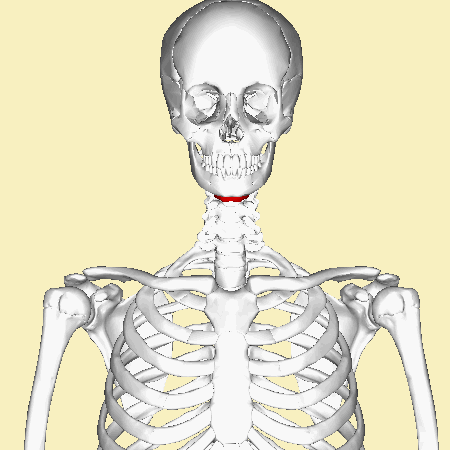Hyoid bone fracture
Editor-In-Chief: Prab R Tumpati, MD
Obesity, Sleep & Internal medicine
Founder, WikiMD Wellnesspedia &
W8MD medical weight loss NYC and sleep center NYC
| Hyoid bone fracture | |
|---|---|

| |
| Synonyms | |
| Pronounce | N/A |
| Specialty | N/A |
| Symptoms | Neck pain, dysphagia, dysphonia, stridor |
| Complications | Airway obstruction, aspiration, infection |
| Onset | |
| Duration | |
| Types | |
| Causes | Blunt trauma, strangulation, hanging |
| Risks | |
| Diagnosis | Physical examination, imaging studies |
| Differential diagnosis | |
| Prevention | |
| Treatment | Airway management, surgical intervention |
| Medication | Analgesics, antibiotics |
| Prognosis | |
| Frequency | Rare |
| Deaths | |
Hyoid Bone Fracture
A hyoid bone fracture is a rare injury that involves a break in the hyoid bone, a U-shaped bone located in the anterior neck. This type of fracture is uncommon due to the protected position of the hyoid bone, which is situated above the larynx and below the mandible.
Anatomy of the Hyoid Bone[edit | edit source]
The hyoid bone is a unique structure in the human body. It is not directly attached to any other bones, making it the only bone that is "free-floating." The hyoid bone serves as an attachment site for muscles associated with swallowing and speech. It consists of a central body and two pairs of horns, the greater and lesser cornua.
Causes of Hyoid Bone Fracture[edit | edit source]
Hyoid bone fractures are typically caused by direct trauma to the neck. Common causes include:
- Strangulation: Manual strangulation or hanging can exert significant force on the neck, leading to a fracture.
- Blunt trauma: Accidents, such as motor vehicle collisions or sports injuries, can result in a fracture if the neck is impacted.
- Penetrating trauma: Stab wounds or gunshot injuries to the neck may also fracture the hyoid bone.
Symptoms[edit | edit source]
Symptoms of a hyoid bone fracture may include:
- Pain in the neck, especially when swallowing or speaking
- Swelling and bruising in the neck area
- Difficulty swallowing (dysphagia)
- Hoarseness or changes in voice
- Respiratory distress in severe cases
Diagnosis[edit | edit source]
Diagnosis of a hyoid bone fracture typically involves:
- Physical examination: A healthcare provider will assess the neck for tenderness, swelling, and other signs of injury.
- Imaging studies: X-rays, CT scans, or MRI may be used to visualize the fracture and assess the extent of the injury.
Treatment[edit | edit source]
Treatment for a hyoid bone fracture depends on the severity of the injury:
- Conservative management: Mild fractures may be treated with rest, pain management, and dietary modifications to ease swallowing.
- Surgical intervention: Severe fractures or those associated with airway compromise may require surgical repair.
Prognosis[edit | edit source]
The prognosis for a hyoid bone fracture is generally good, especially with prompt diagnosis and appropriate treatment. Most individuals recover fully without long-term complications.
See also[edit | edit source]
Search WikiMD
Ad.Tired of being Overweight? Try W8MD's physician weight loss program.
Semaglutide (Ozempic / Wegovy and Tirzepatide (Mounjaro / Zepbound) available.
Advertise on WikiMD
|
WikiMD's Wellness Encyclopedia |
| Let Food Be Thy Medicine Medicine Thy Food - Hippocrates |
Translate this page: - East Asian
中文,
日本,
한국어,
South Asian
हिन्दी,
தமிழ்,
తెలుగు,
Urdu,
ಕನ್ನಡ,
Southeast Asian
Indonesian,
Vietnamese,
Thai,
မြန်မာဘာသာ,
বাংলা
European
español,
Deutsch,
français,
Greek,
português do Brasil,
polski,
română,
русский,
Nederlands,
norsk,
svenska,
suomi,
Italian
Middle Eastern & African
عربى,
Turkish,
Persian,
Hebrew,
Afrikaans,
isiZulu,
Kiswahili,
Other
Bulgarian,
Hungarian,
Czech,
Swedish,
മലയാളം,
मराठी,
ਪੰਜਾਬੀ,
ગુજરાતી,
Portuguese,
Ukrainian
Medical Disclaimer: WikiMD is not a substitute for professional medical advice. The information on WikiMD is provided as an information resource only, may be incorrect, outdated or misleading, and is not to be used or relied on for any diagnostic or treatment purposes. Please consult your health care provider before making any healthcare decisions or for guidance about a specific medical condition. WikiMD expressly disclaims responsibility, and shall have no liability, for any damages, loss, injury, or liability whatsoever suffered as a result of your reliance on the information contained in this site. By visiting this site you agree to the foregoing terms and conditions, which may from time to time be changed or supplemented by WikiMD. If you do not agree to the foregoing terms and conditions, you should not enter or use this site. See full disclaimer.
Credits:Most images are courtesy of Wikimedia commons, and templates, categories Wikipedia, licensed under CC BY SA or similar.
Contributors: Prab R. Tumpati, MD




